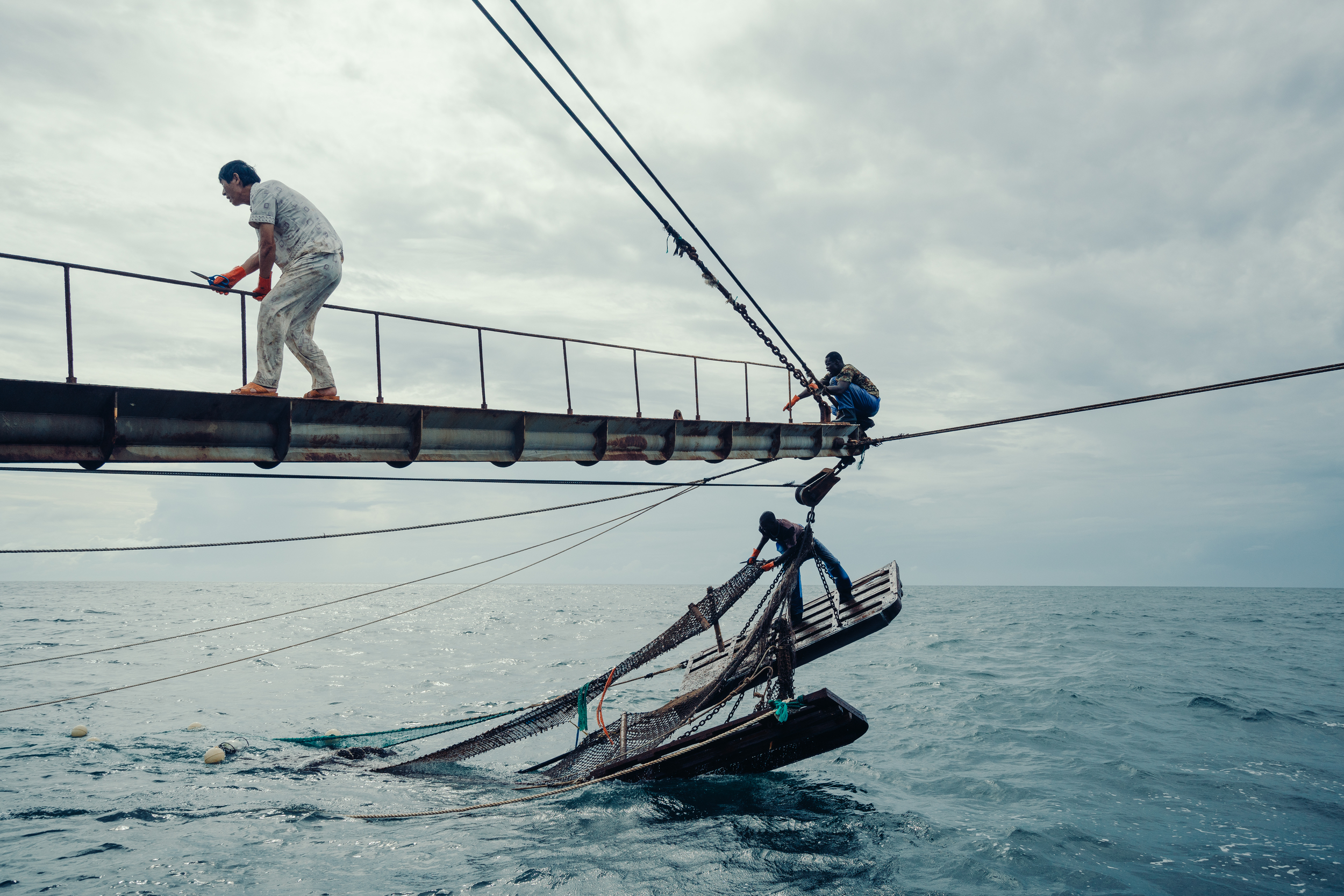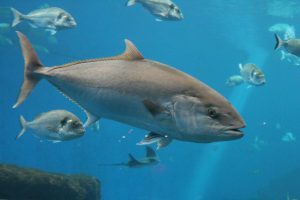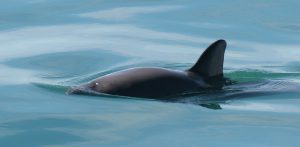On August 13, the Ecuadorean coastguard intercepted a Chinese frozen cargo ship in the waters around the Galapagos Islands. Its cargo was seized and fined US$5.9 million. Twenty Chinese crew members were subsequently given prison sentences of between one and four years.
The frozen cargo ship, the Fu Yuan Yu Leng 999, was intercepted as it was traversing through the waters of the Galapagos Islands. On board the authorities found almost 300 tonnes of fish, including more than 6,600 sharks and the endangered species such as hammerheads.
Director of the Galapagos National Park Walter Bustos told Ecuadorian newspaper El Universo that the vessel was the largest ever seized in connection with illegal fishing in the protected area.
When seized, the Fu Yuan Yu Leng had been moving at the speed of a cargo vessel, travelling in a corridor between islands in the Galapagos, Marine conservation specialist Milko Schvartzman told China Dialogue Ocean in an email:
Ill-equipped to fish itself, the cargo ship – or “reefer” – had been loaded with catch at sea by one or more other fishing vessels.
After the crew of the Fu Yuan Yu Leng 999 were sentenced, Hua Chunying, the spokesperson for the Chinese Foreign Ministry restated that:
“The Chinese government has always opposed any form of illegal fishing,” adding: “The Chinese government always requires Chinese fishing companies to operate legally and protect the marine ecological environment. China trusts that the Ecuadorian authorities will handle this case according to the law, and also protect the legitimate rights and interests of the crew and the company.”
According to an article from Skytruth 28, a nonprofit organisation that uses remote satellite data to monitor the environment, the fish on board the ship were likely off loaded from four Fu Yuan Yu fishing boats.
Working with another non-profit organisaton, Global Fishing Watch, and ship automatic identification system (AIS) records, they discovered that after the cargo ship left Fuzhou port in China on July 7th, it took a month to transit directly to a location 1,700 kilometres west of the Galapagos Islands.
It cruised that area at a slow speed for three days (5-7 August), while maintaining a distance of about 30 metres from four Fu Yuan Yu longliners (the main method for fishing tuna in the South Pacific) for some time. Afterwards, the Fu Yuan Yu Leng 999 headed for the Galapagos Islands, travelling at a standard speed of 10 knots (about 18.5 km/h) through the islands until it was intercepted.
An anonymous source told China Dialogue Ocean that the seized ship, the Fu Yuan Yu Leng 999, belongs to the Fuzhou Honglong Ocean Fishery Company Ltd.
Protection problems
This instance not only highlights the problem of regulating China’s distant water fleet, but also demonstrates the inadequate protection of fishery resources in Latin America and the loopholes in regulating the proliferation of transshipment.
The Galapagos Islands are under the jurisdiction of both the South Pacific Regional Fisheries Management Organisation (SPRFMO) and the Inter-American Tropical Tuna Commission (IATTC).
To enter these waters ships must gain permission from the presiding authority. Ships are granted permits despite the possibility that they will engage in illegal fishing practices in areas that are poorly monitored.
It is impossible to determine whether the boat’s catch originated in the Galapagos Marine Reserve. However, it was in the marine reserve when intercepted and was carrying endangered species of shark, sounding an alarm bell to shark protectors in this region.
Why the Galapagos need protecting
The Galapagos is a UNESCO world heritage site because of its rich marine biodiversity.
It was here that Darwin first noticed differences in how species had evolved on the various islands and devised his theory of evolution that changed the world. The Galapagos Marine Reserve is famous for its sharks, and had the world’s highest abundance. But because of inadequate coast guard patrols and lack of government determination, illegal fishing has always taken place here.
Cesar Cedeno, a PhD student at the University of Pittsburgh, wrote on local media Gkillcity.com: “The great naval challenge of Ecuador is to control a maritime area five times larger than its [land] territory.” But investment in the national coast guard is lacking. Some of the vessels in service are more than 30-years-old and training has suffered from budget cuts.
The Fu Yuan Yu Leng 999 is only one of hundreds of international ships that trawl the waters surrounding Ecuador, Chile and Peru. Many Ecuadorian fishing boats have also been caught in the region. In the last three years alone, Ecuador’s coast guard has caught 17 Ecuadorian vessels engaged in illegal shark finning, shark fin exports and shark capture inside the Galapagos Marine Reserve and the Ecuador Economic Exclusive Zone (EEZ).
Although the Ecuadorian president has states that he will strengthen the capacity of his naval force to prevent more fishing vessels from overseas engaging in illegal fishing, many believe there is a big difference between saying and doing.
Boosting operational funding for monitoring efforts and implementing wider military reforms are key to future change.
The development of a regional response mechanism, as used to deal with crime or pollution, is another option.
Beth Lowell, Oceana’s senior campaign director, told China Dialogue Ocean that transshipment is having a profound impact on the management and sustainability of fisheries resources.
Criminals are able to mix up illegally-caught with legally-caught fish and sell them on as legal catch, effectively fish “laundering”. The frozen cargo ships used to collect and transport the catch are not always inspected in port. They are not required to provide proof of a fishing permit, which seriously undermines the traceability and transparency of their catch sources.
Because of weak regulatory frameworks, cargo vessels do not have their catch checked making it impossible to effectively monitor these transnational criminal activities.
Furthermore, cargo vessels can stay at sea for months or years at a time, allowing human rights abuses to happen as illegal workers are kept away from the eyes of land-based authorities.
Vanishing shark fin
More than 6,000 sharks were found on board the The Fu Yuan Yu Leng 999. Looking at the released images, the sharks have had their fins removed, but it’s not yet known where the fins are.
Shark fin is the most expensive shark meat product and China is the biggest consumer of shark fin. China’s sharks fin consumption has dropped dramatically following changes to officials dining out and publicity around shark protection.
According to a study by the China Aquatic Products Processing and Marketing Alliance on consumption of shark, between 2011 and 2013, consumption of shark fin dropped 70% across the country. The non-profit, WildAid, released a survey in 2014 showing that 85% of Chinese consumers said they had stopped eating shark fin in the past three years.
Customs data from 2004 to 2014 showed that Chinese imports of dried shark fin fell to 20 tonnes in 2014 from 4,774 tonnes in 2004; while exports fell to 278 tonnes in 2014 from 2,476 tonnes in 2004. Other products such as fish oil have also been affected.
But legal and illegal channels of shark trade still exist. In 2015, Ecuadorian police seized about 200,000 shark fins ready for sale in Asia. Also, an anonymous source told chinadialogue, that Hong Kong’s shark fin imports rebounded in 2015 following a period of decline.
Consumption of shark meat worldwide
Although the fin remains the most valuable, traded part of a shark’s anatomy, shark meat is an important part of diets in the developing and developed world. There are more than 400 species of shark in the world, of which more than 100 are commercially exploited.
Even though numbers are declining, according to the Food and Agriculture Organisation of the United Nations (FAO), in 2014, global shark catch amounted to 790,000 tonnes.
Because sharks grow slowly they mature later, which means it takes longer for their numbers to recover from over-fishing. Professor Dai Xiaojie from Shanghai Ocean University said that eight species are now endangered because of over-fishing.
Professor Wang Yamin at Shandong University’s Ocean College, said that the international trade in some shark species (such as the hammerhead shark) was restricted but there was no complete banon shark fishing.
Sharks are also commonly eaten in the coastal province of Fujian in China. Fujianese resident, Zhang Kechao, said he bought shark meat from a market in Xiamen as early as seven or eight years ago for a bit more than 10 yuan (US$1.5) per half kilo, comparable to the price of pork, the most consumed meat in China. But because you need large ships to catch shark meat, nowadays it’s scarcer and found only in big cities.
Because locals prefer to eat freshly killed fish, many people in Xiamen tend to eat shark that has been bred for the purpose.
Some companies, such as Fuzhou Honglong Ocean Fishery Company Ltd, market shark meat to western countries, specifically.
China in Latin American waters
What is certain is that China’s long distance fishing fleets have expanded in recent years, particularly in Latin America.
Chinese fisheries are looking for local development opportunities. Shandong BaoMa Fisheries Limited is planning to invest US$200 million to construct a large fishing port in the Uruguayan capital Montevideo, which has concerned environmentalists who fear the new fishing port could exacerbate over-fishing.
This is also not the first time that a Chinese ship has been stopped in Latin American waters for illegal activities. Just recently, the Hua Li 8, which was flying the Chinese flag, was caught in Argentinian waters engaging in illegal fishing.
Chinese authorities have unambiguously stated that illegal fishing will not be tolerated. China’s Ocean Fisheries Management Revisions says that fishing companies found to be engaged in, supporting, or assisting in any illegal will be disqualified from overseas fleets. Whether these rules have teeth remains to be seen.




![A flood affected resident of Jakhalabandha, Assam on the south bank of the Brahmaputra being evacuated on a raft on August 13, along with the family's livestock [Image by Biju Boro]](https://dialogue.earth/content/uploads/2017/09/Jakhalabandha-flood-300x200.jpg)



